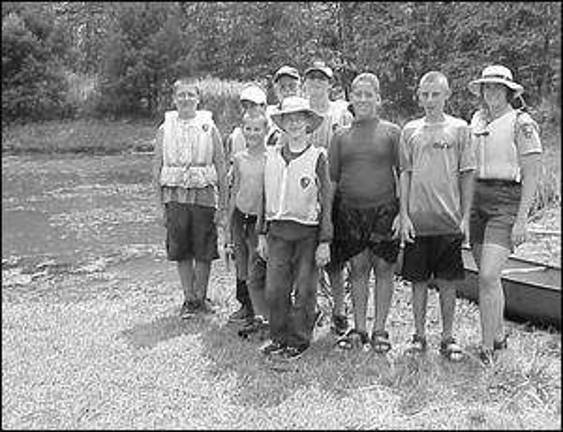Saving the river from Water Chestnuts

NARROWSBURG, N.Y. - Recently, members of Boy Scout Troop 122 of Damascus, helped their community, the environment and the National Park Service. What did they do? They worked hard to remove Water Chestnut, (Trapa natans) from a private pond owned by Floyd Campfield Sr., located in Narrowsburg, N.Y. They did it because the private pond on the Campfield’s property has an outlet that eventually leads to the Delaware River. Water chestnut is an aquatic invasive plant which is not native to the Upper Delaware region. It is native to Europe and Asia and was first observed in the United States in Massachusetts in the late 1800s. As with many invasive plant species, this plant provides no real benefits to the environment that it grows in, or the environment around it. In fact, it can have much the opposite effect, which is precisely why the National Park Service would like to see it eliminated from the Upper Delaware Scenic and Recreational River. The problem with this plant is that Water Chestnut can form dense floating mats, severely limiting light - a critical element of aquatic ecosystems. This plant can also reduce oxygen levels, which may increase the potential for fish kills. It competes with native vegetation and is of little value to waterfowl. Water Chestnut infestations limit boating, fishing, swimming and other recreational activities. The fruit of this plant is a nut (or nutlet) with barbed spines up to 4 1/2 inches long that can cause painful wounds if stepped on. The seeds can remain viable for up to 12 years. Water Chestnut has become a serious invader in other parts of our region including the Hudson River, Lake Champlain and much of Connecticut. The Resource Management division of the park service at the Upper Delaware Scenic and Recreational River has been working to remove Water Chestnut from the river for the past five years. There have been three known locations of this plant growing in the river; one near Milanville, and the two near Narrowsburg. Knowing that the nutlets can remain viable for so long, the National Park Service was very interested in assisting to rid this plant from the Campfield’s pond, to eliminate a source for the nutlets to find their way to the river. Park officials saw this as an excellent opportunity to turn this chore into a service project for the local boy scouts. With the assistance of troop leader and park service volunteer Rich Egan, the Damascus troop got the job done. With a day’s worth of elbow grease and a bit of fun, the boys spent time in canoes and along the shore of the Campfield’s pond, hand pulling the Water Chestnut plants out one by one. After the pond was Water Chestnut free, they did their best to remove as many of the nutlets from the pond bottom as possible; since they can stay viable for so long, this is a very important part of the elimination process. By dedicating 6 hours of their time on a sunny Thursday, Troop 122 scouts did their part to help their local environment and each earned the Service to America badge in the process. Troop 122 is always looking for new members. After Labor Day, they meet every Wednesday evening at 6:30 p.m. in the Damascus United Methodist Church basement. Anyone is welcome to join them.